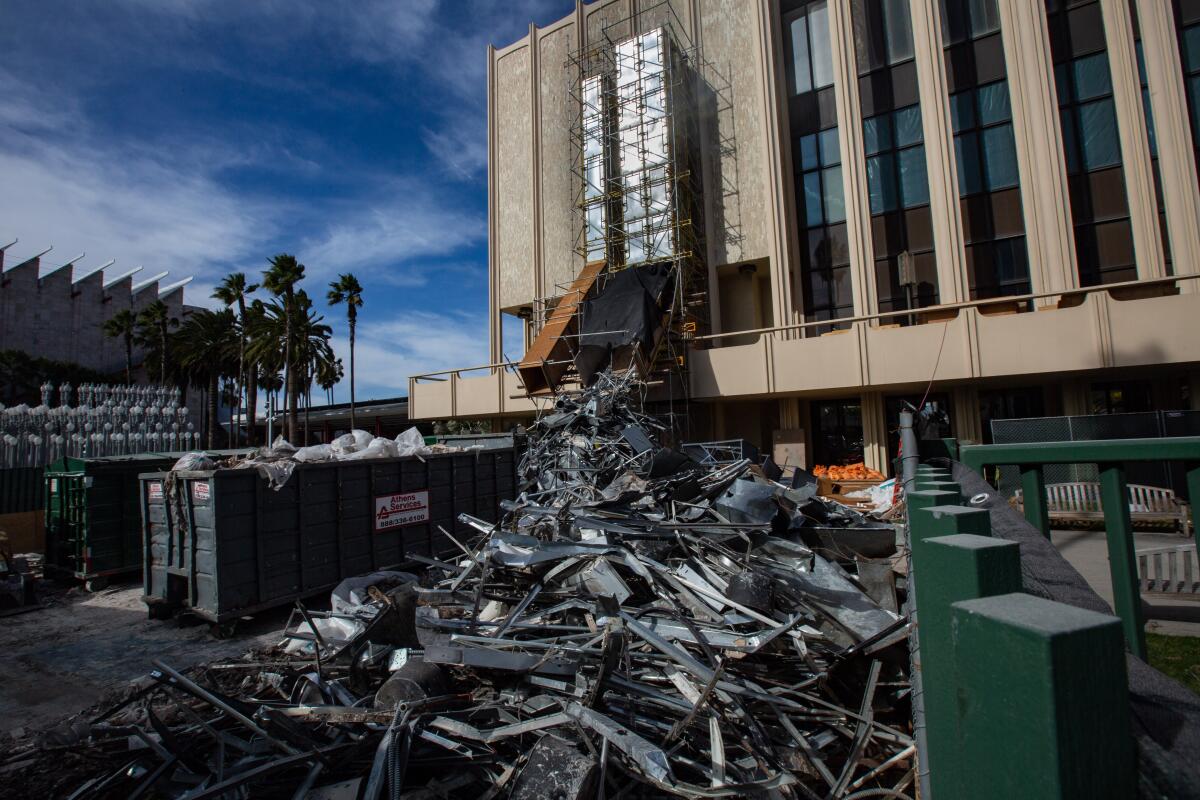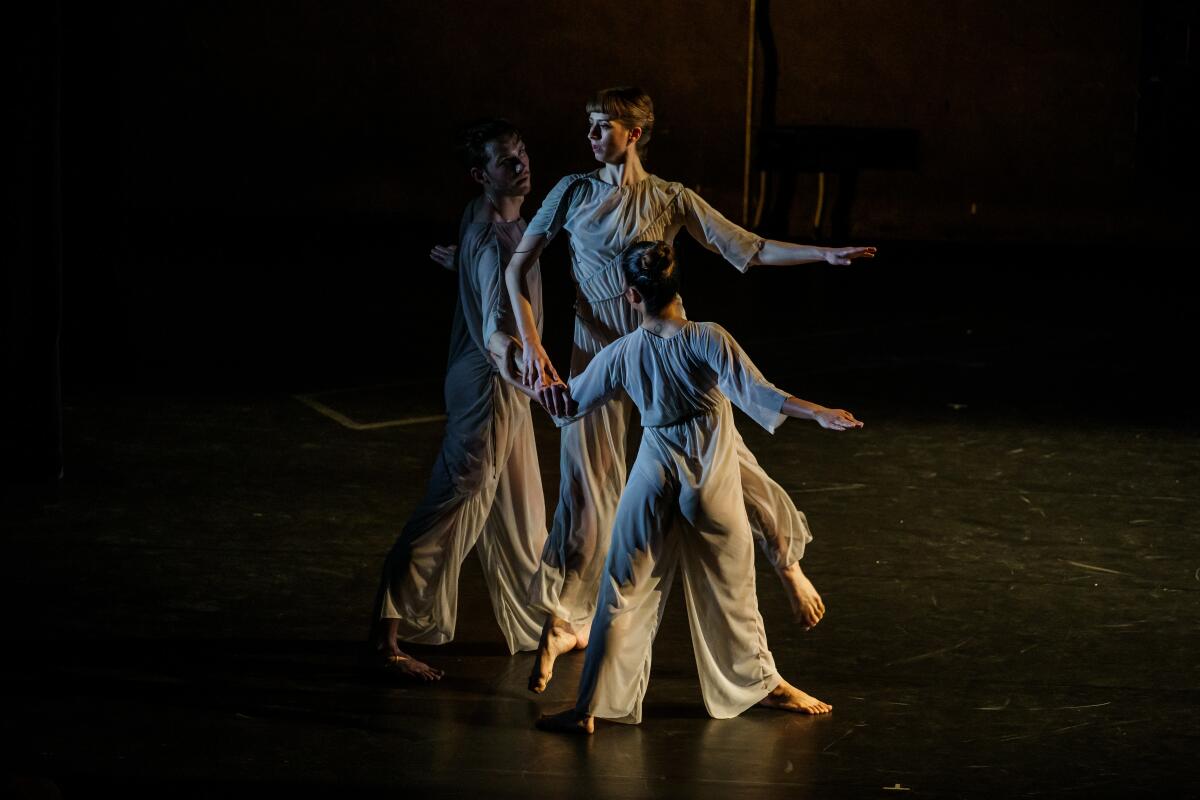Essential Arts: LACMA demolition is just weeks away. Will the budget hold?
- Share via
An imminent museum teardown, a well-deserved prize for art critic Christopher Knight, a modern “Frankenstein,” a divisive “West Side Story,” burlesque that breaks cultural barriers and an engrossing Paul McCarthy show.
I’m Laurie Ochoa, arts and entertainment editor at the Los Angeles Times, guiding you through this week’s essential arts reads while Carolina A. Miranda takes a quick East Coast trip.
Make the most of L.A.
Get our guide to events and happenings in the SoCal arts scene. In your inbox every Monday and Friday morning.
You may occasionally receive promotional content from the Los Angeles Times.
LACMA’s transformative moment
With asbestos removal already in progress, it looks as if nothing will stop the wrecking ball due to demolish four key buildings at the Los Angeles County Museum of Art in a matter of weeks. In place of three 1960s buildings by William L. Pereira & Associates and the Art of the Americas building added in 1986 by Hardy Holzman Pfeiffer, an ambitious single structure designed by Pritzker Prize-winning architect Peter Zumthor is planned.
As Carolina Miranda writes in her examination of LACMA’s debt load, “questions about the radical nature of the design — which includes an unorthodox plan for the building to straddle Wilshire Boulevard — and the project’s steep budget, have come up at every turn.” Miranda looks at the issues cited by the project’s critics — including two different groups that use “Save LACMA” in their names — and compares LACMA’s debt to other museums. It may be a numbers piece, but it’s a fascinating read about a major institution about to undergo tremendous change.

LACMA’s teardown-and-rebuild plan is just one way a museum tries to keep pace with the times. Contributing architecture writer Sam Lubell takes this pivotal moment for the Michael Govan-led museum to examine the different approaches taken by LACMA and New York’s Museum of Modern Art. While MoMA kept the essential structure of its Edward Durell Stone and Philip Goodwin building, the site has been “ever changing,” writes Lubell, with additions and renovations by Philip Johnson, Cesar Pelli, Yoshio Taniguchi and a recently opened expansion by Diller Scofidio + Renfro (architects of The Broad).
At issue, though, are how both plans interact with the cities around them. “The designs for both MoMA and LACMA are serenely beautiful,” Lubell writes. “But both contain outdated thinking about the city around them. ... Neither fully embraces its messy, complicated metropolis, its messy, complicated past and its messy, complicated opportunities.”
Before we leave LACMA, it’s good to remind ourselves that the current museum has undergone massive changes since its Wilshire Boulevard campus opened in 1965. In 2015, Times art critic Christopher Knight wrote about German artist Norbert Kricke’s long-gone “Space Sculpture,” which once was the centerpiece of LACMA’s entrance plaza. “Before there was ‘Urban Light,’ Knight wrote of the Chris Burden selfie magnet, “there was ‘Space Sculpture.’”
Knight time
Let us take a moment to appreciate Times art critic Christopher Knight. On Monday, the Dorothea and Leo Rabkin Foundation announced it was awarding its lifetime achievement award — which includes $50,000 — to Knight, a three-time Pulitzer finalist. “Readers have come to depend upon the frank and fearless voice of Christopher Knight, whose commentary spans contemporary art and artists, art history, architecture, museum practices and ethics,” read a statement from the foundation. “He often brings up questions that specialists worry about but are unwilling to expose to broader scrutiny.” As Rabkin executive director Susan C. Larsen told Times reporter Makeda Easter, “I don’t know what the art world would do without him.”
Not one to rest on his lifetime achievement laurels, Knight was out in the galleries, where he took in Kristy Luck’s first L.A. solo show at Philip Martin Gallery. “Color is the most potentially irrational device in any artist’s toolkit,” Knight writes in his review, “difficult to name and available for random application, and Luck makes the most of the capacity.”
At Honor Fraser Gallery, Knight saw the “sly exhibition” of Joe Sola digitally fabricated prints called “I Drove to San Francisco and Back,” a show that includes “Oscar in Mirror,” a “pretty funny” take on our town’s awards obsession. “Oscar peers at his golden mirror reflection like Greek mythology’s Narcissus at the pool, viscerally entranced,” Knight writes in his review, “but cluelessly unaware that he’s in love with his own gilded likeness.”
Most compelling is Knight’s review of “Paul McCarthy: Head Space, Drawings 1963-2019” at the Hammer Museum. With more than 600 drawings, the show, as Knight writes, is “a lot to take in.” Which is why Knight’s review is essential reading before you go. He talks about how McCarthy brought “dead in the water” Surrealism and Expressionism “roaring to life” and guides us through the stages of McCarthy’s career. “This giant drawing retrospective resonates deeply with the awful age through which we find ourselves currently floundering,” Knight writes. “That’s one sure sign of McCarthy’s artistic significance.”
On stage
Mary Shelley’s “Frankenstein” is a “cautionary myth interpreted and reinterpreted by artists from all disciplines who never lack for contemporary analogies,” writes Times theater critic Charles McNulty in his review of the staging of the novel at the Wallis Annenberg Center for the Performing Arts by Four Larks. “The inventive interdisciplinary performance company has created a fascinating creature from the bones of Shelley’s novel,” McNulty says. “Visually, this ‘Frankenstein’ is enthralling; narratively, the result is often blurrier.”
To find out how the “self-described junkyard opera company” Four Larks dreamed up its “Frankenstein,” Times contributor Jordan Riefe spoke with founders Mat Sweeney (director and composer on the production) and Sebastian Peters-Lazaro (designer-choreographer) and cast members. “In some way,” Sweeney said, “every piece we make has been a Frankenstein, a creature we’ve pasted and glued together.”
McNulty also traveled to New York to see the divisive Broadway production by Ivo van Hove of “West Side Story.” “Controversy was stoked by the jettisoning of Jerome Robbins’ original choreography, the excision of “I Feel Pretty” from the score and the explosion of video in a production that some said threatened to turn the stage into cinema,” McNulty writes in his review. “No, the early word was neither enlightening nor encouraging. But ... let me declare that I am firmly in Van Hove’s camp on this one.”
Times classical music critic Mark Swed found himself at “Four Quartets,” a CAP UCLA staging of four T.S. Eliot poems with an original score by Kaija Saariaho, scenic design with Brice Marden paintings and choreography by Pam Tanowitz. “Saariaho’s incandescent score ... dazzles in its intensity,” Swed writes in his review. Actress Kathleen Chalfant “reads Eliot’s sublime stanzas with a restrained elegance such that each reaches the listener as a marvel of imagery.”

Times contributing reviewer Margaret Gray finds “startlingly pertinent” parallels between Frank Capra’s 1941 film “Meet John Doe” and contemporary America through writer-director Stephen Sachs’ world premiere staging of “Human Interest Story,” a retelling of the film at the Fountain Theatre.
“A high tolerance for indeterminacy is required,” writes Times reviewer Philip Brandes of Lee Blessing’s “surreal, self-described puzzle play” “A Body of Water.” The Actors Co-op production, “revisits the mystery of identity with a newly revised ending in an eerie, thought-provoking staging.”
“The Book of Mormon” has returned to Los Angeles for the fourth time, this time at the Ahmanson Theatre, and Times reviewer Daryl H. Miller was there. He says the jokes may not be aging as well as one would hope, but he has one word to describe the current cast: “Fantastic.”
Miller also took in A Noise Within’s production of Shakespeare’s “The Winter’s Tale,” staged by Geoff Elliott “in what appears to be a fascist country in the 1930s,” Miller writes. “The result, while wholly admirable, reflects the pitfalls as well as the triumphs of broaching the romances.”
And Times contributing reviewer Nikki Munoz writes that “The $5 Shakespeare Company,” by Matthew Leavitt at Theatre 68 in North Hollywood, has a “sharp” script with “a fluid and nuanced plot” and “actors shine individually and as an ensemble with a pulsating chemistry.”
Enjoying this newsletter? Consider subscribing to the Los Angeles Times
Your support helps us deliver the news that matters most. Become a subscriber.
Burlesque barrier breakers
The Times’ Jessica Gelt spent time with the all-Filipina cast of dancers starring in “Burlesque Las FilipinX,” a bawdy show that happens to be sponsored by the Assn. for the Advancement of Filipino American Arts and Culture, or FilAm Arts. Held at the speakeasy-style Genever in L.A.’s historic Filipinotown, the burlesque show is meant to entertain and bring attention to the nontraditional art form.
“You just don’t see our people in those spaces because it’s taboo,” Giselle Töngi-Walters, FilAm Arts’ director of programming tells Gelt. “A lot of us are still trying to break free from gender roles and the colonial mentality of what a Filipina should be.”

Your arts planner
Jessica Gelt has the rundown of the Ahmanson Theatre‘s coming 2020-21 season. Among the anticipated productions: “To Kill a Mockingbird,” “Hadestown” and “The Lehman Trilogy,” directed by Oscar-nominated “1917” filmmaker Sam Mendes.
Gelt also previews this summer’s female-focused Hollywood Bowl lineup, which includes Brandi Carlile, Diana Ross, Janelle Monáe, Cynthia Erivo, Yuja Wang, Brittany Howard “and an evening celebrating the 100th anniversary of the 19th Amendment,” prohibiting the denial of voting rights on the basis of sex.
Matt Cooper’s eight best things to do in L.A. include the Los Angeles Opera production of “Roberto Devereux,” L.A. Dance Project’s reprisal of a Benjamin Millepied work and from dance company Step Afrika! a performance centered on an 18th century slave revolt. You’ll find Cooper’s listings for this week and the week ahead in dance, theater, museums and more on our things to do: arts & culture page.
Also ...
— Zoe Caldwell, four-time Tony winner and the master of “Master Class,” has died at 86.
— The Allentown Art Museum’s “Portrait of a Young Woman” (1632), long attributed to unknown artists in the studio of Rembrandt, was discovered to be a true Rembrandt after a restoration.
— The Philadelpia Inquirer reported that after misconduct allegations against Philadelphia Museum of Art former executive Joshua R. Helmer, employees were demanding “answers about the institution’s tolerance of another well-paid but controversial manager, James A. Cincotta. ... Cincotta slapped, punched, pinched, shoved, grabbed, and verbally berated workers, according to interviews with 14 current and former museum employees.”
And last but not least ...
Heard of the “museum walk”? Hyperallergic’s Hakim Bishara talks with posture specialist Mark Josefsberg about “the unhealthy way in which we tend to move our bodies while seeing art.” How to avoid the lower back pain that often comes with museum visits? Josefsberg says “free your neck,” “lead with your knee” and “don’t plod!”
The biggest entertainment stories
Get our big stories about Hollywood, film, television, music, arts, culture and more right in your inbox as soon as they publish.
You may occasionally receive promotional content from the Los Angeles Times.




